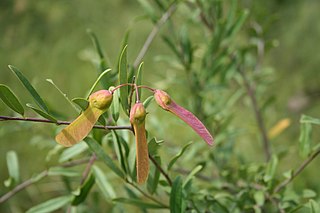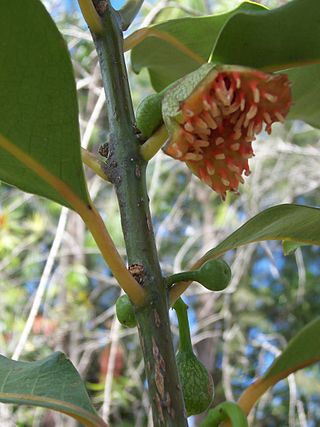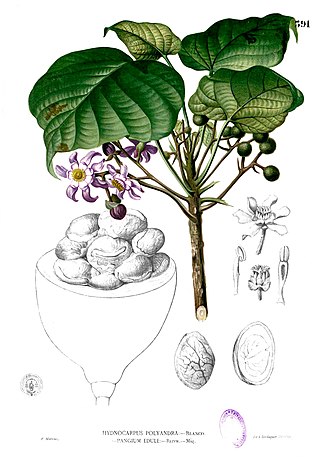
The Dioscoreales are an order of monocotyledonous flowering plants, organized under modern classification systems, such as the Angiosperm Phylogeny Group or the Angiosperm Phylogeny Web. Among monocot plants, Dioscoreales are grouped with the lilioid monocots, wherein they are a sister group to the Pandanales. In total, the order Dioscoreales comprises three families, 22 genera and about 850 species.

Ceratophyllaceae is a cosmopolitan family of flowering plants including one living genus commonly found in ponds, marshes, and quiet streams in tropical and in temperate regions. It is the only extant family in the order Ceratophyllales. Species are commonly called coontails or hornworts, although hornwort is also used for unrelated plants of the division Anthocerotophyta.

Dioscoreaceae is a family of monocotyledonous flowering plants, with about 715 known species in nine genera. The best-known member of the family is the yam.

The Zygophyllales are an order of dicotyledonous plants, comprising the following two families:

The Angiosperm Phylogeny Group (APG) is an informal international group of systematic botanists who collaborate to establish a consensus on the taxonomy of flowering plants (angiosperms) that reflects new knowledge about plant relationships discovered through phylogenetic studies.

Zosteraceae is a family of marine perennial flowering plants found in temperate and subtropical coastal waters, with the highest diversity located around Korea and Japan. Most seagrasses complete their entire life cycle under water, having filamentous pollen especially adapted to dispersion in an aquatic environment and ribbon-like leaves that lack stomata. Seagrasses are herbaceous and have prominent creeping rhizomes. A distinctive characteristic of the family is the presence of characteristic retinacules, which are present in all species except members of Zostera subgenus Zostera.

Asphodelaceae is a family of flowering plants in the order Asparagales. Such a family has been recognized by most taxonomists, but the circumscription has varied widely. In its current circumscription in the APG IV system, it includes about 40 genera and 900 known species. The type genus is Asphodelus.

The Polygalaceae or the milkwort family are made up of flowering plants in the order Fabales. They have a near-cosmopolitan range, with about 27 genera and ca. 900 known species of herbs, shrubs and trees. Over half of the species are in one genus, Polygala, the milkworts.

The Monimiaceae is a family of flowering plants in the magnoliid order Laurales. It is closely related to the families Hernandiaceae and Lauraceae. It consists of shrubs, small trees, and a few lianas of the tropics and subtropics, mostly in the southern hemisphere. The largest center of diversity is New Guinea, with about 75 species. Lesser centres of diversity are Madagascar, Australia, and the neotropics. Africa has one species, Xymalos monospora, as does Southern Chile. Several species are distributed through Malesia and the southwest Pacific.
Phelline is a genus of shrubs and the sole member of the family Phellinaceae, a family of flowering plants endemic to New Caledonia. It is placed in the order Asterales and is related to two other small plant families: Alseuosmiaceae and Argophyllaceae. It contains ten species.

Achariaceae is a family of flowering plants consisting of 31 genera and about 155 species of tropical herbs, shrubs, and trees. The APG IV system has greatly expanded the scope of the family by including many genera previously classified in Flacourtiaceae. Molecular data strongly support the inclusion of this family in the order Malpighiales.

Chrysobalanaceae is a family of flowering plants, consisting of trees and shrubs in 27 genera and about 700 species of pantropical distribution with a centre of diversity in the Amazon. Some of the species contain silica in their bodies for rigidity and so the mesophyll often has sclerenchymatous idioblasts. The widespread species Chrysobalanus icaco produces a plum-like fruit and the plant is commonly known as the coco plum.

Peridiscaceae is a family of flowering plants in the order Saxifragales. Four genera comprise this family: Medusandra, Soyauxia, Peridiscus, and Whittonia., with a total of 12 known species. It has a disjunct distribution, with Peridiscus occurring in Venezuela and northern Brazil, Whittonia in Guyana, Medusandra in Cameroon, and Soyauxia in tropical West Africa. Whittonia is possibly extinct, being known from only one specimen collected below Kaieteur Falls in Guyana. In 2006, archeologists attempted to rediscover it, however, it proved unsuccessful.

Ixiolirion is a genus of flowering plants native to central and southwest Asia, first described as a genus in 1821. Recent classifications place the group in the monogeneric family Ixioliriaceae in the order Asparagales of the monocots. In earlier systems of classification, it was usually placed in the family Amaryllidaceae.

Tofieldiaceae is a family of flowering plants in the monocot order Alismatales. The family is divided into four genera, which together comprise 28 known species. They are small, herbaceous plants, mostly of arctic and subarctic regions, but a few extend further south, and one genus is endemic to northern South America and Florida. Tofieldia pusilla is sometimes grown as an ornamental.

James Lauritz Reveal was a U.S. botanist best known for his contributions to the genus Eriogonum and for his work on suprageneric names. His website, at PlantSystematics.org, also presents material on plant taxonomy including the Reveal system. He published extensively on North American flora, was a member of the Angiosperm Phylogeny Group, and was one of the authors of the APG II and APG III classifications.

Schoepfiaceae is a family of flowering plants recognized in the APG III system of 2009. The family was previously only recognized by few taxonomists; the plants in question usually being assigned to family Olacaceae and Santalaceae.

Haloragaceae is a eudicot flowering plant family in the order Saxifragales, based on the phylogenetic APG system. In the Cronquist system, it was included in the order Haloragales.
Nicobariodendron is a genus in the family Celastraceae, with only one species, Nicobariodendron sleumeri, a tree with simple, alternately set, entire leaves, small flowers and single seed fleshy fruits. It is only known from the Nicobar Islands of India.

Kimnachia is a monotypic genus of cacti. Its only species is Kimnachia ramulosa, synonym Pseudorhipsalis ramulosa, which is native from southern Mexico to northern South America and also found in Jamaica.


















